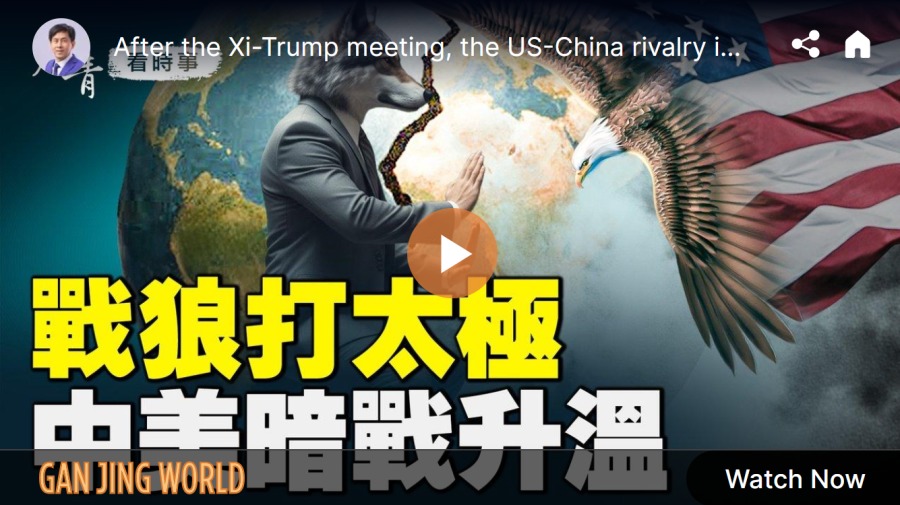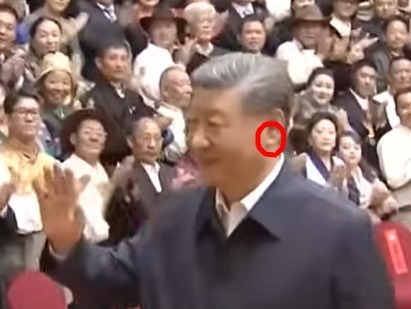US–China Shadow War (video screen snapshot)
[People News] In the past month or two, have you also felt a change—China and the United States suddenly don’t seem to be arguing as loudly. From the Busan meeting to mutual official visits, the atmosphere appears much softer than in previous years.
But don’t be fooled by the appearance. My own observation is that easing is only on the surface; competition is the essence. The United States has regained confidence and now holds the advantage, while the Chinese Communist Party (CCP) is being forced into strategic retreat. On the surface the two sides are polite, but in reality they are both holding back big moves.
And now, with the Trump–Xi meeting just concluded, the hidden competition between China and the U.S. is still intense, extending all the way from high technology down to supply chains, agriculture and food, and even into crucial materials like rare earths.
Today we will talk in detail about the strategic contest between the United States and China.
The “Softened Posture” Behind U.S.–China Relations: A Strategic Retreat
In recent months, the CCP’s attitude toward the U.S. in diplomatic settings has indeed become more restrained—unlike the past few years when it would slip into “wolf warrior mode” and shout at everything. Does that mean Beijing truly wants to improve relations? Don’t be naïve; that’s basically an illusion.
The CCP’s softening is largely forced by reality. China’s economy is declining, supply chains are moving out, and high tech is being strangled. Beijing can no longer hold up appearances and is forced to step back.
The United States, however, is in a completely different position: its economy is relatively stable, its technology continues to lead, its relationships with allies are improving, and it holds the initiative in the trade war. Its overall strategic confidence is rising.
This power gap forces the CCP to trade its old “high-pressure confrontation” strategy for today’s “low-profile buffering.”
Commentator Zhao Xiao has also pointed out that after several years of confrontation, the CCP has gained a clearer view of the real balance of power. The gap is not shrinking—it is widening. Since it cannot challenge the U.S. in the short term, what can it do?
Change the playbook: drag out time, avoid direct collisions, wait for opportunities.
He gives several examples. In the border clash between Thailand and Cambodia, China did not step in aggressively but even acknowledged U.S. mediation. The Busan meeting was held on a U.S. base—Beijing did not dare complain. Toward Japan, Korea, and other neighbors, Beijing is focusing on communication, avoiding misjudgment, and not stirring up major incidents. All of this shows that the CCP’s diplomatic priority has shifted from posturing and asserting positions to quietly safeguarding practical interests.
Zhao Xiao compares current U.S.–China relations to the U.S.–Soviet Cold War. Back then, arms-control agreements bought each side breathing room. Today’s U.S. and China are similar—limited cooperation within a broader framework of competition. In short, both sides know the contradictions are insoluble, but a real fight would consume both, so they try to maintain a minimal order amidst competition.
His assessment: future U.S.–China relations will likely be dominated by competition as the norm, controlled conflict, and only occasional cooperation.
In other words, no war—but far from peace. Some issues might see episodic cooperation, but within the larger structure, competition is everywhere.
And precisely because of this, when the CCP softens its posture, what it is really doubling down on are the deeper fronts—high tech, supply chains, agriculture, rare earths—each battlefield more intense than before.
So let’s start with the most sensitive and explosive one: high technology and cyberwar.
High Tech and Cyberwar: The Alibaba Incident Ignites Tensions
When talking about U.S.–China competition, high technology and cyberspace are always the most sensitive areas—not only tied to the economy, but also the “first battlefield” of future warfare.
The focal point this time is the Chinese e-commerce giant Alibaba.
On November 14, The Financial Times revealed a partially declassified White House national security memo. It accused Alibaba of providing sensitive data and technical support to the CCP government and even the military. This includes U.S. users’ IP addresses, Wi-Fi information, payment records, and AI-related services.
Even worse, Alibaba employees were accused of transferring “zero-day vulnerability” knowledge to the Chinese military—those unknown software flaws that developers haven’t patched yet, which are highly sensitive cyberattack tools.
These are not ordinary data; they are military-grade intelligence tools capable of targeting U.S. systems.
Alibaba immediately denied the allegations, and the Chinese Embassy in Washington jumped out to say the report “completely distorts the facts.” You may notice that this is Beijing’s standard response every time it gets caught. But the problem is, this kind of accusation is far from new—and they are coming out more frequently.
What does the U.S. Congress think? House Select Committee on the CCP Chairman John Moolenaar said this confirms Congress’s longstanding concern: Chinese law requires all enterprises, no matter where they operate, to cooperate with the government.
In other words, any Chinese company is subject to military–civil fusion.
Moolenaar urged the U.S. government and industry to act and cut off all channels that let Chinese companies access the U.S. market or U.S. innovation. In May, he and other lawmakers called on the SEC to delist 25 Chinese companies—Alibaba among them.
Congress’s attitude is clear: this is not a business issue; it is a national-security issue.
Former CIA China analyst Dennis Wilder also warned that the scope of PLA cyber-penetration is “unprecedented in both breadth and depth.” Targets include U.S. airports, ports, Pacific military transport nodes, and domestic critical facilities—all aimed at preparing for possible future military conflict.
And in the same week that Alibaba was accused, another incident made Washington even more alarmed. U.S. AI company Anthropic disclosed that it stopped a “largely AI-autonomous cyber-espionage operation,” attributed to a Chinese state-backed hacking group known as GTG-1002.
Although this event was not directly connected to Alibaba, the two incidents together strengthened U.S. conclusions that Beijing is systematically using advanced technology to infiltrate American networks.
So the Alibaba incident is not just one company getting exposed. It is a signal: the U.S. will now treat Chinese tech firms as “military risks,” not normal private companies.
For the U.S., high tech and data security are the first line of defense in a new cold war. For the CCP, Chinese tech firms were never purely private—they are part of the state machinery, an extension of cyberwarfare.
Tesla and GM’s “De-China-ization” Operation
Against the backdrop of intense technological and cybersecurity conflicts, U.S. companies are starting to “self-protect.” Most notably two major automakers—Tesla and General Motors—which are rapidly shifting their supply chains out of China.
First, The Wall Street Journal reported on November 15 that Tesla has explicitly instructed suppliers not to use China-made components for vehicles manufactured in U.S. factories.
Sources say that under Elon Musk’s direction, Tesla and its suppliers have already replaced some Chinese-made parts and plan to relocate the remaining ones outside China within one to two years.
Tesla actually began reducing reliance on Chinese-made components after the pandemic, and this “escape from China” only accelerated under Trump-era tariff hikes.
Back in April, Reuters reported that Tesla had dramatically increased reliance on North American supply chains over the past two years to counter tariff risks.
Another key factor recently emerged: a dispute between China and the Netherlands disrupted automotive-chip supply. This pushed Tesla’s internal discussions about “accelerating supply-chain diversification” into overdrive.
Next, General Motors. According to Reuters on November 12, GM has ordered thousands of suppliers to remove all China-related parts from their supply chains.
Sources said GM set deadlines for certain suppliers: by 2027 they must completely end procurement ties with China.
The report said GM began issuing these orders in late 2024, but as the U.S.–China trade war escalated rapidly this spring, the process became more urgent. GM executives described it as a major strategic adjustment to strengthen supply-chain “resilience.”
Sources added that the focus is on parts and materials used in vehicles produced in North America, where most GM cars are manufactured. GM prefers to source from North American factories but accepts suppliers from countries other than China.
Trump’s tariffs and China’s tightened export controls on rare-earth-related auto components have put U.S. automakers and suppliers into “emergency mode.”
MEMA (Motor & Equipment Manufacturers Association) leader Collin Shaw said automakers and major suppliers have long reduced sourcing from China and other “sensitive countries” to lower risks. But he admitted that China’s raw-material and basic-component network was built over 20–30 years, and dismantling it in just a few years is impossible.
Agriculture: The New Battlefield—Soybean-Purchase Promises Questioned
After technology and supply chains, let’s turn to another crucial and sensitive region: agriculture, especially soybeans.
On October 30, U.S. Treasury Secretary Scott Bessent announced that China had agreed to purchase 25 million tons of American soybeans annually over the next three years, and would buy 12 million tons before January next year.
Sounds like a massive order, right? But on November 14, USDA data quickly poured cold water on this “big promise.”
The data shows that after the Busan meeting, China bought only 332,000 tons of U.S. soybeans—not even 3% of the pledged amount. The AP reported that Beijing never publicly confirmed the purchase agreement, only stating that both sides “reached a consensus to expand agricultural trade”—very vague wording.
U.S. Agriculture Secretary Brooke Rollins said even if China promised to buy soybeans, it would only purchase if the price is attractive enough.
Agricultural economist Tanner Ehmke explained the key: China already stocked up on huge quantities from Brazil and South America this year. Brazilian soybeans are cheaper. U.S. soybeans are more expensive. So China has little incentive to buy from the U.S.
In other words, they can promise verbally, but actual purchases depend on price—not political commitments.
This is bad news for American soybean farmers. Prices have dropped again due to trade uncertainty, increasing pressure on U.S. farmers. Discussions have already begun about whether tariff revenue should be used to subsidize affected farmers.
In short, the agricultural front of the U.S.–China conflict is highly unstable. The gap between “promises” and “reality” could become the fuse for the next clash—but it’s too soon to say. What is certain is that the soybean issue will continue to come under intense scrutiny.
Rare-Earth Front: The CCP’s Pause Is Not a Relaxation
Let’s talk about one of the most vital battlegrounds in U.S.–China competition — rare earths.
Rare earth materials look insignificant, but they play a massive role. Fighter jets, missiles, electric vehicles, motor magnets, key components of semiconductor equipment… These high-end systems can be crippled by the absence of even one type of rare-earth material. So rare earths are absolutely strategic resources.
A Bloomberg report on November 14 said that, according to insiders, the U.S. and the CCP have not reached a real outcome in rare-earth negotiations. The two sides are discussing a so-called “general license,” but it has not been finalized.
The U.S. believes this license should restore normal rare-earth exports and reduce risks; but Beijing has not expressed any stance on the details.
Bloomberg also noted that Washington equates the CCP’s pause with “lifting restrictions,” but Beijing has never admitted this — not even responded.
This lack of clarity has left rare-earth exporters in a wait-and-see state. Several companies said they are still waiting for new guidance.
After the latest U.S.–China trade talks, China suspended several of the heavy restrictions announced on October 9, including:
-
Products containing medium and heavy rare earths
-
Rare-earth processing equipment
-
Technical documents related to rare earths (blueprints, processes, parameters)
-
Overseas products containing more than 0.1% China-origin rare earths
-
Lithium battery materials and graphite anode-material equipment
-
Synthetic diamond and other super-hard material equipment
At first glance, the one-year suspension does look like significant easing. But when you look at what Beijing didn’t touch, the picture becomes very different:
-
“Ban on exporting all dual-use items to U.S. military end-users” — unchanged.
-
The rare-earth licensing system coming into effect in April 2025 — unchanged.
-
Export controls on tungsten, indium, bismuth, molybdenum — unchanged.
In other words, the CCP suspended the “outer branches,” but did not suspend the parts that truly strangle U.S. access.
The Foundation for Defense of Democracies (FDD) warned in an article that the U.S. should view this pause as a tactical window — and use it to advance cooperation with Australia, Japan, and Canada to build rare-earth supply chains; expand “ally-shoring”; accelerate domestic mining-permit reform; and establish shortage early-warning mechanisms.
So what’s next?
Will the U.S. and China maintain this “controlled competition”?
Or will one field crack first and trigger a new conflict flashpoint?
— Tang Qing Current Affairs Production Team
△










News magazine bootstrap themes!
I like this themes, fast loading and look profesional
Thank you Carlos!
You're welcome!
Please support me with give positive rating!
Yes Sure!